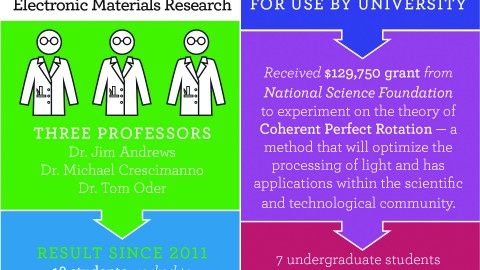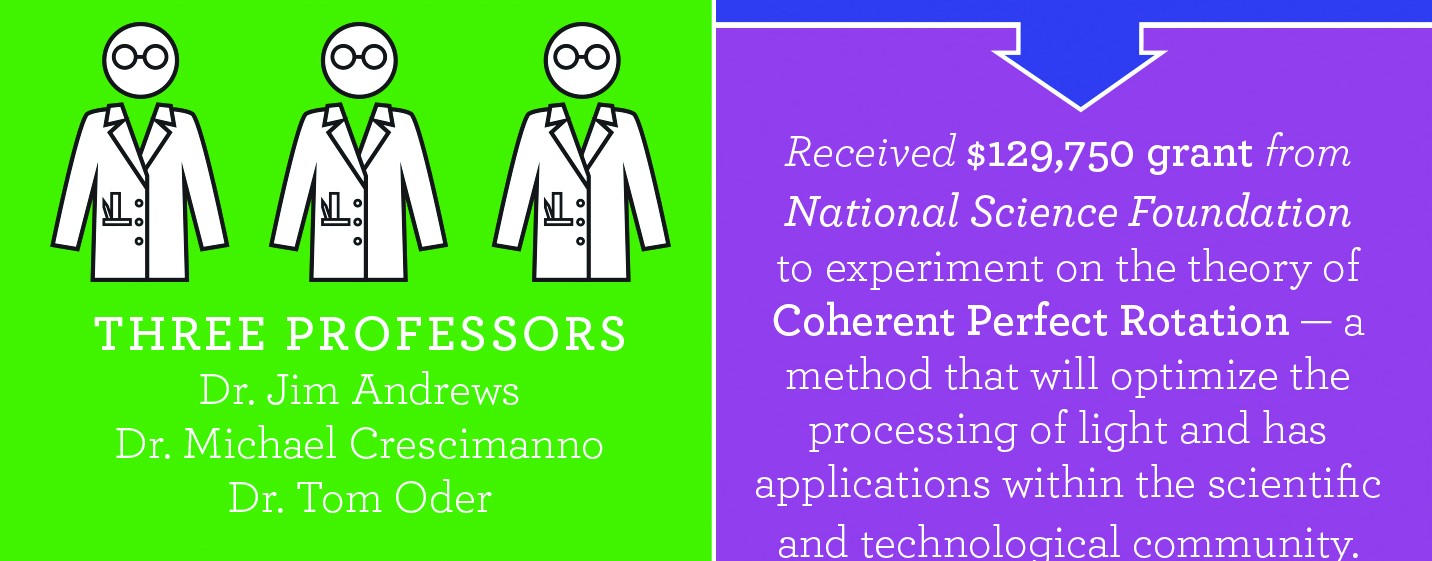By Justin Wier

Under Photonic, Optical and Electronic Materials Research, Jim Andrews and Michael Crescimanno, physics professors at Youngstown State University, were recently awarded a grant for $129,750 by the National Science Foundation for Research into a process they call coherent perfect rotation.
Coherent perfect rotation perfectly converts light from one polarization to another, which will optimize the processing of light.
Crescimanno and Andrews started working together six years ago. Crescimanno had returned from Harvard where a fellow colleague was doing research, using nanoparticles to perform magneto-optic rotation, which Crescimanno was skeptical about.
“I kind of derisively called it nanojunk, and I remember coming back, and [Andrews] was into this nanolayered polymer stuff,” Crescimanno said. “I remember when we first talked about it I was skeptical about it, and then we ended up collaborating.”
Since then they have done a lot of work on lasers. They found a way to make lasers from polymers rather than silicon, which can allow you to stretch, fold or change the temperature of the polymer to alter the wavelength.
Research done at Yale involving anti-lasers led them to investigate the idea of coherent perfect rotation. An anti-laser absorbs coherent light — a type of light that is made up of waves all in the same wavelength and in phase — and turned into a type of internal energy.
“[An anti-laser] is a system that instead of taking energy and coherently producing light out like a laser, it involves sending coherent light in and having nothing come out,” Andrews said.
Scientists have developed materials that do not emit photons, the elementary particle that light and all other forms of electromagnetic radiation are composed of, but those materials have limitations in their utility. The anti-laser and coherent perfect rotations are more flexible.
“If you create that kind of exotic material, you basically have the material and that’s what its properties are,” Andrews said. “What the Yale group did that’s different, and what we’re doing that’s different, is we can turn it on and off at will with the interference properties of our light fields. They can turn the blackness of something on and off, and we can turn the polarization properties of a system on and off by controlling them with another light beam.”
Crescimanno used noise-cancelling headphones as a way of understanding the technology.
“What do those things do? They listen to the ambient noise field of the sound and they generate kind of anti-noise. So the two waves, when they meet your eardrum, destructively interfere. So in a sense what we’re doing is kind of related to that, but it uses interference and symmetry in a more profound way,” he said.
Their technology also preserves the energy in the light, as opposed to absorbing it.
“[An anti-laser is] just kind of a place where light goes and dies. But actually making something that can controllably change the polarization of light technologically might be more useful than just something to absorb it, because you’re not losing light, you’re still processing light,” Crescimanno said. “In a sense, what we’re talking about is a very high efficiency way of processing that light. [When you’re] just absorbing light, it’s gone, [and] you can’t do anything subsequently with it, but with ours you could.”
Andrews elaborated.
“In our scheme, which involves this polarization of light, we’re just converting the light from one polarization to another perfectly. And if you then take that field and want to convert it back or use it for something else, it’s all there,” he said. “The efficiency of the switching we could do is very high because we didn’t lose any of the energy by doing this.”
After they submit a paper about the technology, they hope to move on to miniaturizing it to increase the number of potential applications.
“What we got funded for in a sense was just a proof of principle, an experimental proof of principle for this theoretical idea, and we’d like to take it to the next stage,” Crescimanno said.
Their research is also benefitting students.
“One thing that might be useful for readers to know is how many opportunities exist for students to get involved with an experiment either here or in other groups, and not just in physics,” Crescimanno said. ”So, if you’re responsible and can work independently and have a little bit of drive. You can get paid while you’re learning and doing this stuff and you really have your own experiment. Some of the stuff ended up being published.”
Andrews cited 12 papers since 2011 that have included 18 different YSU students as co-authors.
Michael Baker, a senior physics major, was a co-author on the most recent paper they had published.
“It was a great honor for them to ask me to help them with that paper,” Baker said. “It’s not an opportunity you usually get at other universities, to get published as an undergrad.”
They’ve also used students outside the physics department as research assistants.
“We’ve had about a dozen students for the past two summers, each summer working with us and then students working during the regular school year from physics, electrical engineering, mechanical engineering, chemical engineering and math,” Andrews said. “And we’re looking for more. We hope some students will be interested in joining us this summer.”
It’s an opportunity to do unprecedented things.
“We’re doing fun things,” Crescimanno said. “I think we can pretty confidently claim, the things we’re doing, they’ve never been done anywhere else in the world.”
